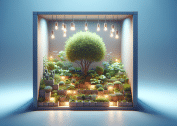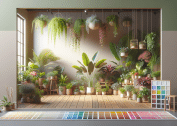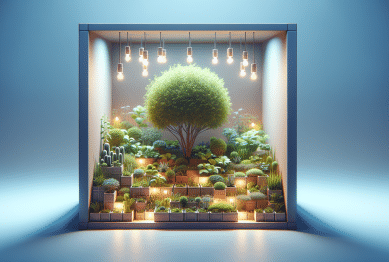Uncover the practical ways indoor plants can boost your home’s look and your well-being. This in-depth guide explores choosing, caring for, and styling houseplants, as well as how they improve air quality, enhance décor, and support mental health.
Understanding the Power of Indoor Plants in Home Design
Indoor plants have steadily become essential in home design, valued for their ability to add warmth and texture to any space. Whether placed on windowsills, shelves, or in hanging baskets, houseplants create inviting atmospheres that personalize a room. Many people find even small greenery touches have an impressive impact. Spaces that might feel sterile or bland suddenly become vibrant with just a few carefully placed plants. Their colors and shapes break up dull lines, making living spaces look curated and welcoming.
The integration of indoor greenery goes beyond aesthetics. Plants have been found to support emotional wellness by reducing stress and increasing feelings of calm (see https://www.ncbi.nlm.nih.gov/pmc/articles/PMC4419447/). In rooms where stress or anxiety may run high, such as home offices or bedrooms, the presence of indoor plants can create a relaxing effect that invites deep breaths and more mindful living. Their presence can also serve as a mindful ritual, inviting brief moments of care each day.
Homeowners increasingly see indoor plants as versatile design tools. From modern minimalist flats to classic homes, plants anchor interior styles. Plants like Fiddle Leaf Fig or Monstera create statement accents, while succulents and air plants offer subtle enhancement. The plant’s container also matters—sleek ceramics, eco-friendly baskets, or repurposed jars all contribute to a defined look. By understanding the design potential of houseplants, anyone can easily introduce unique character to their home.
Choosing the Right Indoor Plants for Your Space
Selecting the right indoor plants depends on your home’s conditions and your personal style. Light levels, humidity, and available floor or shelf space all play a role. For sunny rooms, opt for sun-loving species like succulents or rubber plants. In shadier spots, snake plants or pothos thrive with limited natural light. If you lead a busy lifestyle, consider varieties like ZZ plants or cacti, which require less frequent watering and attention.
Size also matters when choosing houseplants. Compact options like spider plants or fittonia add life to desks and bookshelves. Tall, leafy options like the bird of paradise or palm varieties can fill empty corners and even serve as privacy screens. Some people prefer to cluster several small plants together, creating a ‘mini jungle’ effect, while others choose a single striking specimen. It’s all about matching plant choice to your needs and your home’s unique microclimate.
Start with a short list of favorite houseplants and do a little research on their ideal environment. You’ll find that some, like peace lilies, even perform double duty by purifying the air. When in doubt, consult reputable gardening sites or extension services for advice (find guidance at https://extension.psu.edu/houseplants). Selecting plants suited to your home ensures they’ll flourish and keep your living space feeling fresh.
Indoor Plant Benefits: Air Quality and Beyond
One of the most celebrated effects of indoor plants is their ability to naturally clean the air. Research has shown that certain houseplants can reduce levels of common indoor pollutants, including formaldehyde and benzene (review more at https://www.nasa.gov/feature/nasa-researchers-find-new-way-to-clean-air-in-space). While a single plant won’t transform an entire home, multiple plants can work together to noticeably improve air quality. This is helpful in urban apartments or older homes where ventilation may be limited.
Beyond air purification, plants can also help regulate humidity inside the home. Through transpiration, leafy houseplants add moisture to dry indoor environments—which can be a relief during winter months. This benefit supports overall comfort, and may even help those prone to dry skin or respiratory irritation. Layering a mix of tropical and hardy species supports a balanced indoor ecosystem that’s both beautiful and functional.
Evidence also points to cognitive and mental health advantages from bringing greenery indoors. Multiple studies highlight improved concentration, memory, and even creativity in people who keep houseplants close (see https://www.apa.org/monitor/2019/04/ce-corner-office). Children, too, may benefit in terms of learning and stress reduction. The positive psychological effects of plants add real value—making them far more than just decorative pieces in your room.
Essential Tips for Plant Care and Maintenance
Caring for indoor plants is straightforward once basic needs are understood. Most houseplants require regular but not excessive watering. A good rule is to check soil moisture before adding water; overwatering is a common misstep that can lead to root rot. Investing in pots with drainage holes helps prevent this and keeps plants healthy for longer. Occasional misting, especially for tropical varieties, fosters optimal humidity levels indoors.
Light is another vital aspect of plant care. Each species has its own preference—from direct sunlight for succulents to indirect, filtered light for ferns. Position your plants according to light availability, rotating them occasionally to encourage even growth. Dusting leaves or gently wiping them with a damp cloth ensures the plants can absorb maximum sunlight. For more in-depth plant care guides, many extension agencies provide detailed resources (visit https://hgic.clemson.edu/factsheet/houseplants-care-and-maintenance/).
Feeding your indoor garden is also key. Slow-release fertilizers, applied according to plant guidelines, support lush growth. It’s helpful to research specific plant needs, as some flourish with regular feeding while others may thrive on neglect. Regularly inspect for pests such as spider mites or aphids and remove affected leaves as soon as possible. With consistent attention and care, any enthusiast can maintain a flourishing indoor garden no matter their experience level.
Styling Your Home with Indoor Plants
Styling with indoor plants opens endless creativity. Arrangement plays a large role. Consider groupings of plants of varying heights for a layered effect, or place a dramatic specimen on a statement table to draw the eye. Even the selection of pots and planters influences your home’s style—modern metallics, woven baskets, terracotta, or recycled containers each project a unique look.
Plants can be more than accents—they’re functional design tools. Use them to fill empty corners, screen unsightly views, or divide an open-concept space into zones. Trailing species like philodendron or pothos work well on shelves or high places, where leafy vines drape artfully. Conversely, architectural varieties such as snake plants or cacti introduce modern shapes to contemporary interiors.
Personalizing a plant display adds a special touch. For those with creative flair, swapping decorative pots seasonally refreshes a room without new furniture. Adding a few rare or unusual species as conversation starters brings character. Ultimately, styling with indoor plants is about expressing individuality. No two collections will ever look quite the same, making each home uniquely inviting and alive.
Mental Wellness and Other Surprising Benefits
Many are surprised to learn that indoor plants deliver more than physical benefits—mental wellness may flourish too. Being surrounded by greenery is linked with reduced rates of depression, lower anxiety, and increased positive mood (according to https://pubmed.ncbi.nlm.nih.gov/32027299/). Whether tending to a thriving garden or nurturing a single small plant, the process offers mindfulness and encourages daily routine.
Indoor gardening provides unique sensory engagement. The scent of fresh soil, touch of velvety leaves, and sight of sprouting growth all anchor people in the present. This can be especially beneficial for those working from home or experiencing isolation. For families, involving children in care routines instills responsibility and a sense of accomplishment as plants grow big and strong.
The satisfaction of nurturing plants often transfers to other areas of home and life. Celebrating new buds or blooms sparks happiness and pride, reinforcing positive reinforcement loops. It’s a simple yet effective self-care strategy that nearly anyone can incorporate, with lasting benefits for both body and mind. Exploring these subtle perks is as rewarding as transforming your home with greenery.
References
1. Bringslimark, T., Hartig, T., & Patil, G. G. (2009). The psychological benefits of indoor plants: A critical review of the experimental literature. Retrieved from https://www.ncbi.nlm.nih.gov/pmc/articles/PMC4419447/
2. NASA. (n.d.). NASA researchers find new way to clean air in space. Retrieved from https://www.nasa.gov/feature/nasa-researchers-find-new-way-to-clean-air-in-space
3. Chawla, S.L., & Raghava, M.M. (n.d.). Houseplants. Penn State Extension. Retrieved from https://extension.psu.edu/houseplants
4. Clemson Cooperative Extension. (n.d.). Houseplants: Care and Maintenance. Retrieved from https://hgic.clemson.edu/factsheet/houseplants-care-and-maintenance/
5. American Psychological Association. (2019). Office greenery boosts employee well-being. Retrieved from https://www.apa.org/monitor/2019/04/ce-corner-office
6. Qureshi, M.S., et al. (2020). Effects of indoor plants on mood and cognitive function: A systematic review. Retrieved from https://pubmed.ncbi.nlm.nih.gov/32027299/











 Can Collagen Supplements Improve Your Skin
Can Collagen Supplements Improve Your Skin 

